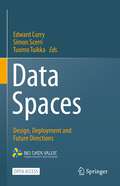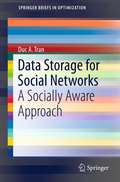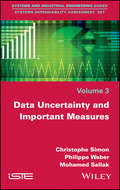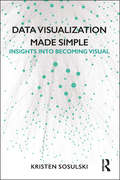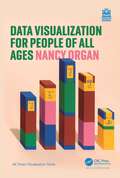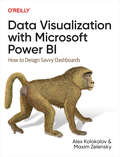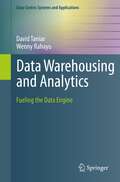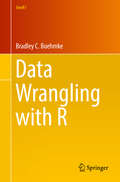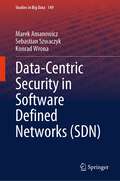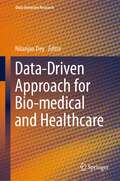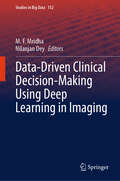- Table View
- List View
Data Science: Time Complexity, Inferential Uncertainty, And Spacekime Analytics (De Gruyter Stem Series)
by Ivo D. Dinov Milen Velchev VelevThe amount of new information is constantly increasing, faster than our ability to fully interpret and utilize it to improve human experiences. Addressing this asymmetry requires novel and revolutionary scientific methods and effective human and artificial intelligence interfaces. By lifting the concept of time from a positive real number to a 2D complex time (kime), this book uncovers a connection between artificial intelligence (AI), data science, and quantum mechanics. It proposes a new mathematical foundation for data science based on raising the 4D spacetime to a higher dimension where longitudinal data (e.g., time-series) are represented as manifolds (e.g., kime-surfaces). This new framework enables the development of innovative data science analytical methods for model-based and model-free scientific inference, derived computed phenotyping, and statistical forecasting. The book provides a transdisciplinary bridge and a pragmatic mechanism to translate quantum mechanical principles, such as particles and wavefunctions, into data science concepts, such as datum and inference-functions. It includes many open mathematical problems that still need to be solved, technological challenges that need to be tackled, and computational statistics algorithms that have to be fully developed and validated. Spacekime analytics provide mechanisms to effectively handle, process, and interpret large, heterogeneous, and continuously-tracked digital information from multiple sources. The authors propose computational methods, probability model-based techniques, and analytical strategies to estimate, approximate, or simulate the complex time phases (kime directions). This allows transforming time-varying data, such as time-series observations, into higher-dimensional manifolds representing complex-valued and kime-indexed surfaces (kime-surfaces). The book includes many illustrations of model-based and model-free spacekime analytic techniques applied to economic forecasting, identification of functional brain activation, and high-dimensional cohort phenotyping. Specific case-study examples include unsupervised clustering using the Michigan Consumer Sentiment Index (MCSI), model-based inference using functional magnetic resonance imaging (fMRI) data, and model-free inference using the UK Biobank data archive. The material includes mathematical, inferential, computational, and philosophical topics such as Heisenberg uncertainty principle and alternative approaches to large sample theory, where a few spacetime observations can be amplified by a series of derived, estimated, or simulated kime-phases. The authors extend Newton-Leibniz calculus of integration and differentiation to the spacekime manifold and discuss possible solutions to some of the "problems of time". The coverage also includes 5D spacekime formulations of classical 4D spacetime mathematical equations describing natural laws of physics, as well as, statistical articulation of spacekime analytics in a Bayesian inference framework. The steady increase of the volume and complexity of observed and recorded digital information drives the urgent need to develop novel data analytical strategies. Spacekime analytics represents one new data-analytic approach, which provides a mechanism to understand compound phenomena that are observed as multiplex longitudinal processes and computationally tracked by proxy measures. This book may be of interest to academic scholars, graduate students, postdoctoral fellows, artificial intelligence and machine learning engineers, biostatisticians, econometricians, and data analysts. Some of the material may also resonate with philosophers, futurists, astrophysicists, space industry technicians, biomedical researchers, health practitioners, and the general public.
Data Scientists at Work
by Sebastian GutierrezData Scientists at Work is a collection of interviews with sixteen of the world's most influential and innovative data scientists from across the spectrum of this hot new profession. 'Data scientist is the sexiest job in the 21st century, ' according to the Harvard Business Review. By 2018, the United States will experience a shortage of 190,000 skilled data scientists, according to a McKinsey report. Through incisive in-depth interviews, this book mines the what, how, and why of the practice of data science from the stories, ideas, shop talk, and forecasts of its preeminent practitioners across diverse industries: social network (Yann LeCun, Facebook); professional network (Daniel Tunkelang, LinkedIn); venture capital (Roger Ehrenberg, IA Ventures); enterprise cloud computing and neuroscience (Eric Jonas, formerly Salesforce. com); newspaper and media (Chris Wiggins, The New York Times); streaming television (Caitlin Smallwood, Netflix); music forecast (Victor Hu, Next Big Sound); strategic intelligence (Amy Heineike, Quid); environmental big data (Andre? Karpis'ts'enko, Planet OS); geospatial marketing intelligence (Jonathan Lenaghan, PlaceIQ); advertising (Claudia Perlich, Dstillery); fashion e-commerce (Anna Smith, Rent the Runway); specialty retail (Erin Shellman, Nordstrom); email marketing (John Foreman, MailChimp); predictive sales intelligence (Kira Radinsky, SalesPredict); and humanitarian nonprofit (Jake Porway, DataKind). The book features a stimulating foreword by Google's Director of Research, Peter Norvig. Each of these data scientists shares how he or she tailors the torrent-taming techniques of big data, data visualization, search, and statistics to specific jobs by dint of ingenuity, imagination, patience, and passion. Data Scientists at Work parts the curtain on the interviewees' earliest data projects, how they became data scientists, their discoveries and surprises in working with data, their thoughts on the past, present, and future of the profession, their experiences of team collaboration within their organizations, and the insights they have gained as they get their hands dirty refining mountains of raw data into objects of commercial, scientific, and educational value for their organizations and clients.
Data Spaces: Design, Deployment and Future Directions
by Edward Curry Simon Scerri Tuomo TuikkaThis open access book aims to educate data space designers to understand what is required to create a successful data space. It explores cutting-edge theory, technologies, methodologies, and best practices for data spaces for both industrial and personal data and provides the reader with a basis for understanding the design, deployment, and future directions of data spaces.The book captures the early lessons and experience in creating data spaces. It arranges these contributions into three parts covering design, deployment, and future directions respectively. The first part explores the design space of data spaces. The single chapters detail the organisational design for data spaces, data platforms, data governance federated learning, personal data sharing, data marketplaces, and hybrid artificial intelligence for data spaces.The second part describes the use of data spaces within real-world deployments. Its chapters are co-authored with industry experts and include case studies of data spaces in sectors including industry 4.0, food safety, FinTech, health care, and energy.The third and final part details future directions for data spaces, including challenges and opportunities for common European data spaces and privacy-preserving techniques for trustworthy data sharing.The book is of interest to two primary audiences: first, researchers interested in data management and data sharing, and second, practitioners and industry experts engaged in data-driven systems where the sharing and exchange of data within an ecosystem are critical.
Data Stewardship for Open Science: Implementing FAIR Principles
by Barend MonsData Stewardship for Open Science: Implementing FAIR Principles has been written with the intention of making scientists, funders, and innovators in all disciplines and stages of their professional activities broadly aware of the need, complexity, and challenges associated with open science, modern science communication, and data stewardship. The FAIR principles are used as a guide throughout the text, and this book should leave experimentalists consciously incompetent about data stewardship and motivated to respect data stewards as representatives of a new profession, while possibly motivating others to consider a career in the field. The ebook, avalable for no additional cost when you buy the paperback, will be updated every 6 months on average (providing that significant updates are needed or avaialble). Readers will have the opportunity to contribute material towards these updates, and to develop their own data management plans, via the free Data Stewardship Wizard.
Data Storage for Social Networks: A Socially Aware Approach (SpringerBriefs in Optimization)
by Duc A. TranEvidenced by the success of Facebook, Twitter, and LinkedIn, online social networks (OSNs) have become ubiquitous, offering novel ways for people to access information and communicate with each other. As the increasing popularity of social networking is undeniable, scalability is an important issue for any OSN that wants to serve a large number of users. Storing user data for the entire network on a single server can quickly lead to a bottleneck, and, consequently, more servers are needed to expand storage capacity and lower data request traffic per server. Adding more servers is just one step to address scalability. The next step is to determine how best to store the data across multiple servers. This problem has been widely-studied in the literature of distributed and database systems. OSNs, however, represent a different class of data systems. When a user spends time on a social network, the data mostly requested is her own and that of her friends; e.g., in Facebook or Twitter, these data are the status updates posted by herself as well as that posted by the friends. This so-called social locality should be taken into account when determining the server locations to store these data, so that when a user issues a read request, all its relevant data can be returned quickly and efficiently. Social locality is not a design factor in traditional storage systems where data requests are always processed independently. Even for today's OSNs, social locality is not yet considered in their data partition schemes. These schemes rely on distributed hash tables (DHT), using consistent hashing to assign the users' data to the servers. The random nature of DHT leads to weak social locality which has been shown to result in poor performance under heavy request loads. Data Storage for Social Networks: A Socially Aware Approach is aimed at reviewing the current literature of data storage for online social networks and discussing new methods that take into account social awareness in designing efficient data storage.
Data Structure Practice: for Collegiate Programming Contests and Education
by Yonghui Wu Jiande WangCombining knowledge with strategies, Data Structure Practice for Collegiate Programming Contests and Education presents the first comprehensive book on data structure in programming contests. This book is designed for training collegiate programming contest teams in the nuances of data structure and for helping college students in computer-related
Data Structures and Algorithms Using C#
by Michael McmillanC# programmers: no more translating data structures from C++ or Java to use in your programs! Mike McMillan provides a tutorial on how to use data structures and algorithms plus the first comprehensive reference for C# implementation of data structures and algorithms found in the . NET Framework library, as well as those developed by the programmer. The approach is very practical, using timing tests rather than Big O notation to analyze the efficiency of an approach. Coverage includes arrays and array lists, linked lists, hash tables, dictionaries, trees, graphs, and sorting and searching algorithms, as well as more advanced algorithms such as probabilistic algorithms and dynamic programming. This is the perfect resource for C# professionals and students alike.
Data Structures: Abstraction And Design Using Java
by Elliot B. Koffman Paul A. T. WolfgangData Structures: Abstraction and Design Using Java offers a coherent and well-balanced presentation of data structure implementation and data structure applications with a strong emphasis on problem solving and software design. Step-by-step, the authors introduce each new data structure as an abstract data type (ADT), explain its underlying theory and computational complexity, provide its specification in the form of a Java interface, and demonstrate its implementation as one or more Java classes. Case studies using the data structures covered in the chapter show complete and detailed solutions to real-world problems, while a variety of software design tools are discussed to help students “Think, then code.” The book supplements its rigorous coverage of basic data structures and algorithms with chapters on sets and maps, balanced binary search trees, graphs, event-oriented programming, testing and debugging, and other key topics. Now available as an enhanced e-book, the fourth edition of Data Structures: Abstraction and Design Using Java enables students to measure their progress after completing each section through interactive questions, quick-check questions, and review questions.
Data Uncertainty and Important Measures
by Christophe Simon Philippe Weber Mohamed SallakThe first part of the book defines the concept of uncertainties and the mathematical frameworks that will be used for uncertainty modeling. The application to system reliability assessment illustrates the concept. In the second part, evidential networks as a new tool to model uncertainty in reliability and risk analysis is proposed and described. Then it is applied on SIS performance assessment and in risk analysis of a heat sink. In the third part, Bayesian and evidential networks are used to deal with important measures evaluation in the context of uncertainties.
Data Visualization Made Simple: Insights into Becoming Visual
by Kristen SosulskiData Visualization Made Simple is a practical guide to the fundamentals, strategies, and real-world cases for data visualization, an essential skill required in today’s information-rich world. With foundations rooted in statistics, psychology, and computer science, data visualization offers practitioners in almost every field a coherent way to share findings from original research, big data, learning analytics, and more. In nine appealing chapters, the book: examines the role of data graphics in decision-making, sharing information, sparking discussions, and inspiring future research; scrutinizes data graphics, deliberates on the messages they convey, and looks at options for design visualization; and includes cases and interviews to provide a contemporary view of how data graphics are used by professionals across industries Both novices and seasoned designers in education, business, and other areas can use this book’s effective, linear process to develop data visualization literacy and promote exploratory, inquiry-based approaches to visualization problems.
Data Visualization for People of All Ages (ISSN)
by Nancy OrganData visualization is the art and science of making information visible. On paper and in our imaginations, it’s a language of shapes and colors that holds our best ideas and most important questions. As we find ourselves swimming in data of all kinds, visualization can help us to understand, express, and explore the richness of the world around us. No matter your age or background, this book opens the door to new ways of thinking and sharing through the power of data visualization.Data Visualization for People of All Ages is a field guide to visual literacy, born from the author’s personal experience working with world-class scholars, engineers, and scientists. By walking through the different ways of showing data—including color, angle, position, and length—you’ll learn how charts and graphs truly work so that no visualization is ever a mystery or out of reach. It doesn’t stop at what fits on a page, either. You’ll journey into cutting-edge topics like data sonification and data physicalization, using sound and touch to share data across the different senses. Packed with practical examples and exercises to help you connect the dots, this book will teach you how to create and understand data visualizations on your own—all without writing a single line of code or getting tangled up in software.Written with accessibility in mind, this book invites everyone to the table to share the joy of one of today’s most necessary skills. Perfect for home or classroom use, this friendly companion gives people of all ages everything they need to start visualizing with confidence.
Data Visualization with Category Theory and Geometry: With a Critical Analysis and Refinement of UMAP (Mathematics of Data #3)
by Jürgen Jost Parvaneh Joharinad Lukas Silvester Barth Hannaneh Fahimi Janis KeckThis open access book provides a robust exposition of the mathematical foundations of data representation, focusing on two essential pillars of dimensionality reduction methods, namely geometry in general and Riemannian geometry in particular, and category theory. Presenting a list of examples consisting of both geometric objects and empirical datasets, this book provides insights into the different effects of dimensionality reduction techniques on data representation and visualization, with the aim of guiding the reader in understanding the expected results specific to each method in such scenarios. As a showcase, the dimensionality reduction method of &“Uniform Manifold Approximation and Projection&” (UMAP) has been used in this book, as it is built on theoretical foundations from all the areas we want to highlight here. Thus, this book also aims to systematically present the details of constructing a metric representation of a locally distorted metric space, which is essentially the problem that UMAP is trying to address, from a more general perspective. Explaining how UMAP fits into this broader framework, while critically evaluating the underlying ideas, this book finally introduces an alternative algorithm to UMAP. This algorithm, called IsUMap, retains many of the positive features of UMAP, while improving on some of its drawbacks.
Data Visualization with Microsoft Power BI: How to Design Savvy Dashboards
by Alex Kolokolov Maxim ZelenskyThe sheer volume of business data has reached an all-time high. Using visualizations to transform this data into useful and understandable information can facilitate better decision-making. This practical book shows data analysts as well as professionals in finance, sales, and marketing how to quickly create visualizations and build savvy dashboards.Alex Kolokolov from Data2Speak and Maxim Zelensky from Intelligent Business explain in simple and clear language how to create brilliant charts with Microsoft Power BI and follow best practices for corporate reporting. No technical background is required. Step-by-step guides help you set up any chart in a few clicks and avoid common mistakes. Also, experienced data analysts will find tips and tricks on how to enrich their reports with advanced visuals.This book helps you understand:The basic rules for classic charts that are used in 90% of business reportsExceptions to general rules based on real business casesBest practices for dashboard designHow to properly set up interactionsHow to prepare data for advanced visualsHow to avoid pitfalls with eye-catching charts
Data Visualization: A Practical Introduction
by Kieran HealyAn accessible primer on how to create effective graphics from dataThis book provides students and researchers a hands-on introduction to the principles and practice of data visualization. It explains what makes some graphs succeed while others fail, how to make high-quality figures from data using powerful and reproducible methods, and how to think about data visualization in an honest and effective way.Data Visualization builds the reader’s expertise in ggplot2, a versatile visualization library for the R programming language. Through a series of worked examples, this accessible primer then demonstrates how to create plots piece by piece, beginning with summaries of single variables and moving on to more complex graphics. Topics include plotting continuous and categorical variables; layering information on graphics; producing effective “small multiple” plots; grouping, summarizing, and transforming data for plotting; creating maps; working with the output of statistical models; and refining plots to make them more comprehensible.Effective graphics are essential to communicating ideas and a great way to better understand data. This book provides the practical skills students and practitioners need to visualize quantitative data and get the most out of their research findings.Provides hands-on instruction using R and ggplot2Shows how the “tidyverse” of data analysis tools makes working with R easier and more consistentIncludes a library of data sets, code, and functions
Data Visualization: Charts, Maps, and Interactive Graphics (ASA-CRC Series on Statistical Reasoning in Science and Society)
by Robert GrantThis is the age of data. There are more innovations and more opportunities for interesting work with data than ever before, but there is also an overwhelming amount of quantitative information being published every day. Data visualisation has become big business, because communication is the difference between success and failure, no matter how clever the analysis may have been. The ability to visualize data is now a skill in demand across business, government, NGOs and academia. Data Visualization: Charts, Maps, and Interactive Graphics gives an overview of a wide range of techniques and challenges, while staying accessible to anyone interested in working with and understanding data. Features: Focusses on concepts and ways of thinking about data rather than algebra or computer code. Features 17 short chapters that can be read in one sitting. Includes chapters on big data, statistical and machine learning models, visual perception, high-dimensional data, and maps and geographic data. Contains more than 125 visualizations, most created by the author. Supported by a website with all code for creating the visualizations, further reading, datasets and practical advice on crafting the images. Whether you are a student considering a career in data science, an analyst who wants to learn more about visualization, or the manager of a team working with data, this book will introduce you to a broad range of data visualization methods. Cover image: Landscape of Change uses data about sea level rise, glacier volume decline, increasing global temperatures, and the increasing use of fossil fuels. These data lines compose a landscape shaped by the changing climate, a world in which we are now living. Copyright © Jill Pelto (jillpelto.com).
Data Visualization: Exploring and Explaining With Data (Mindtap Course List Series)
by Jeffrey D. Camm James J. Cochran Jeffrey W. Ohlmann Michael J. FryDATA VISUALIZATION: Exploring and Explaining with Data is designed to introduce best practices in data visualization to undergraduate and graduate students. <p><p>The book contains material on effective design, choice of chart type, effective use of color, how to explore data visually, and how to explain concepts and results visually in a compelling way with data. In an increasingly data-driven economy, these concepts are becoming more important for analysts, natural scientists, social scientists, engineers, medical professionals, business professionals, and virtually everyone who needs to interact with data. Indeed, the skills developed in this book will be helpful to all who want to influence with data or be accurately informed by data.
Data Visualization: a successful design process
by Andy KirkA comprehensive yet quick guide to the best approaches to designing data visualizations, with real examples and illustrative diagrams. Whatever the desired outcome ensure success by following this expert design process. This book is for anyone who has responsibility for, or is interested in trying to find innovative and effective ways to visually analyze and communicate data. There is no skill, no knowledge and no role-based pre-requisites or expectations of anyone reading this book.
Data Warehousing and Analytics: Fueling the Data Engine (Data-Centric Systems and Applications)
by David Taniar Wenny RahayuThis textbook covers all central activities of data warehousing and analytics, including transformation, preparation, aggregation, integration, and analysis. It discusses the full spectrum of the journey of data from operational/transactional databases, to data warehouses and data analytics; as well as the role that data warehousing plays in the data processing lifecycle. It also explains in detail how data warehouses may be used by data engines, such as BI tools and analytics algorithms to produce reports, dashboards, patterns, and other useful information and knowledge.The book is divided into six parts, ranging from the basics of data warehouse design (Part I - Star Schema, Part II - Snowflake and Bridge Tables, Part III - Advanced Dimensions, and Part IV - Multi-Fact and Multi-Input), to more advanced data warehousing concepts (Part V - Data Warehousing and Evolution) and data analytics (Part VI - OLAP, BI, and Analytics).This textbook approaches data warehousing from the case study angle. Each chapter presents one or more case studies to thoroughly explain the concepts and has different levels of difficulty, hence learning is incremental. In addition, every chapter has also a section on further readings which give pointers and references to research papers related to the chapter. All these features make the book ideally suited for either introductory courses on data warehousing and data analytics, or even for self-studies by professionals. The book is accompanied by a web page that includes all the used datasets and codes as well as slides and solutions to exercises.
Data Wrangling with R
by Bradley C. BoehmkeThis guide for practicing statisticians, data scientists, and R users and programmers will teach the essentials of preprocessing: data leveraging the R programming language to easily and quickly turn noisy data into usable pieces of information. Data wrangling, which is also commonly referred to as data munging, transformation, manipulation, janitor work, etc., can be a painstakingly laborious process. Roughly 80% of data analysis is spent on cleaning and preparing data; however, being a prerequisite to the rest of the data analysis workflow (visualization, analysis, reporting), it is essential that one become fluent and efficient in data wrangling techniques.This book will guide the user through the data wrangling process via a step-by-step tutorial approach and provide a solid foundation for working with data in R. The author's goal is to teach the user how to easily wrangle data in order to spend more time on understanding the content of the data. By the end of the book, the user will have learned: How to work with different types of data such as numerics, characters, regular expressions, factors, and datesThe difference between different data structures and how to create, add additional components to, and subset each data structureHow to acquire and parse data from locations previously inaccessibleHow to develop functions and use loop control structures to reduce code redundancyHow to use pipe operators to simplify code and make it more readableHow to reshape the layout of data and manipulate, summarize, and join data sets
Data and Safety Monitoring Committees in Clinical Trials (Chapman & Hall/CRC Biostatistics Series)
by Jay HersonPraise for the first edition: "Given the author’s years of experience as a statistician and as a founder of the first DMC in pharmaceutical industry trials, I highly recommend this book—not only for experts because of its cogent and organized presentation, but more importantly for young investigators who are seeking information about the logistical and philosophical aspects of a DMC." -S. T. Ounpraseuth, The American Statistician In the first edition of this well-regarded book, the author provided a groundbreaking and definitive guide to best practices in pharmaceutical industry data monitoring committees (DMCs). Maintaining all the material from the first edition and adding substantial new material, Data and Safety Monitoring Committees in Clinical Trials, Second Edition is ideal for training professionals to serve on their first DMC as well as for experienced clinical and biostatistical DMC members, sponsor and regulatory agency staff. The second edition guides the reader through newly emerging DMC responsibilities brought about by regulations emphasizing risk vs benefit and the emergence of risk-based monitoring. It also provides the reader with many new statistical methods, clinical trial designs and clinical terminology that have emerged since the first edition. The references have been updated and the very popular end-of-chapter Q&A section has been supplemented with many new experiences since the first edition. New to the Second Edition: Presents statistical methods, tables, listings and graphs appropriate for safety review, efficacy analysis and risk vs benefit analysis, SPERT and PRISMA initiatives. Newly added interim analysis for efficacy and futility section. DMC responsibilities in SUSARs (Serious Unexpected Serious Adverse Reactions), basket trials, umbrella trials, dynamic treatment strategies /SMART trials, pragmatic trials, biosimilar trials, companion diagnostics, etc. DMC responsibilities for data quality and fraud detection (Fraud Recovery Plan) Use of patient reported outcomes of safety Use of meta analysis and data outside the trial New ideas for training and compensation of DMC members Jay Herson is Senior Associate, Biostatistics, Johns Hopkins Bloomberg School of Public Health where he teaches courses on clinical trials and drug development based on his many years experience in clinical trials in academia and the pharmaceutical industry.
Data in Society: Challenging Statistics in an Age of Globalisation
by Jeff Evans, Sally Ruane and Humphrey SouthallStatistical data and evidence-based claims are increasingly central to our everyday lives. Critically examining ‘Big Data’, this book charts the recent explosion in sources of data, including those precipitated by global developments and technological change. It sets out changes and controversies related to data harvesting and construction, dissemination and data analytics by a range of private, governmental and social organisations in multiple settings. Analysing the power of data to shape political debate, the presentation of ideas to us by the media, and issues surrounding data ownership and access, the authors suggest how data can be used to uncover injustices and to advance social progress.
Data on Federal Research and Development Investments: A Pathway to Modernization
by National Research Council of the National AcademiesTwo surveys of the National Science Foundation's Division of Science Resources Statistics (SRS) provide some of the most significant data available to understand research and development spending and policy in the United States. These are the Survey of Federal Funds for Research and Development and the Survey of Federal Science and Engineering Support to Universities, Colleges, and Nonprofit Institutions. These surveys help reach conclusions about fundamental policy questions, such as whether a given field of research is adequately funded, whether funding is balanced among fields, and whether deficiencies in funding may be contributing to a loss of U.S. scientific or economic competitiveness. However, the survey data are of insufficient quality and timeliness to support many of the demands put on them. In addition the surveys are increasingly difficult to conduct in times of constrained resources, and their technological, procedural, and conceptual infrastructure has not been modernized for procedure or content. Data on Federal Research and Development Investments reviews the uses and collection of data on federal funds and federal support for science and technology and recommends future directions for the program based on an assessment of these uses and the adequacy of the surveys. The book also considers the classification structure, or taxonomy, for the fields of science and engineering.
Data-Centric Security in Software Defined Networks (Studies in Big Data #149)
by Marek Amanowicz Sebastian Szwaczyk Konrad WronaThe book focuses on applying the data-centric security (DCS) concept and leveraging the unique capabilities of software-defined networks (SDN) to improve the security and resilience of corporate and government information systems used to process critical information and implement business processes requiring special protection. As organisations increasingly rely on information technology, cyber threats to data and infrastructure can significantly affect their operations and adversely impact critical business processes. Appropriate authentication, authorisation, monitoring, and response measures must be implemented within the perimeter of the system to protect against adversaries. However, sophisticated attackers can compromise the perimeter defences and even remain in the system for a prolonged time without the owner being aware of these facts. Therefore, new security paradigms such as Zero Trust and DCS aimto provide defence under the assumption that the boundary protections will be breached. Based on experience and lessons learned from research on the application of DCS to defence systems, the authors present an approach to integrating the DCS concept with SDN. They introduce a risk-aware approach to routing in SDN, enabling defence-in-depth and enhanced security for data in transit. The book describes possible paths for an organisation to transition towards DCS, indicating some open and challenging issues requiring further investigation. To allow interested readers to conduct detailed studies and evaluate the exemplary implementation of DCS over SDN, the text includes a short tutorial on using the emulation environment and links to the websites from which the software can be downloaded.
Data-Driven Approach for Bio-medical and Healthcare (Data-Intensive Research)
by Nilanjan DeyThe book presents current research advances, both academic and industrial, in machine learning, artificial intelligence, and data analytics for biomedical and healthcare applications. The book deals with key challenges associated with biomedical data analysis including higher dimensions, class imbalances, smaller database sizes, etc. It also highlights development of novel pattern recognition and machine learning methods specific to medical and genomic data, which is extremely necessary but highly challenging. The book will be useful for healthcare professionals who have access to interesting data sources but lack the expertise to use data mining effectively.
Data-Driven Clinical Decision-Making Using Deep Learning in Imaging (Studies in Big Data #152)
by Nilanjan Dey M. F. MridhaThis book explores cutting-edge medical imaging advancements and their applications in clinical decision-making. The book contains various topics, methodologies, and applications, providing readers with a comprehensive understanding of the field's current state and prospects. It begins with exploring domain adaptation in medical imaging and evaluating the effectiveness of transfer learning to overcome challenges associated with limited labeled data. The subsequent chapters delve into specific applications, such as improving kidney lesion classification in CT scans, elevating breast cancer research through attention-based U-Net architecture for segmentation and classifying brain MRI images for neurological disorders. Furthermore, the book addresses the development of multimodal machine learning models for brain tumor prognosis, the identification of unique dermatological signatures using deep transfer learning, and the utilization of generative adversarial networks to enhance breast cancer detection systems by augmenting mammogram images. Additionally, the authors present a privacy-preserving approach for breast cancer risk prediction using federated learning, ensuring the confidentiality and security of sensitive patient data. This book brings together a global network of experts from various corners of the world, reflecting the truly international nature of its research.


